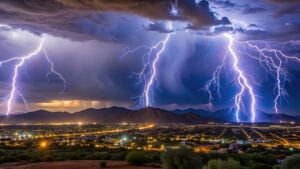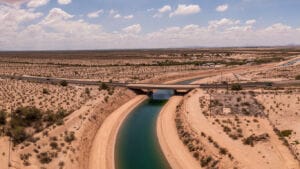Arizonans face perpetual drought with an understanding that being good water stewards is essential to life in the desert.
The current water shortage crippling California reinforces the importance of Arizona’s continuing conservation and management of this finite resource.
Clarkdale Mayor Doug Von Gausig is the executive director of the Verde River Institute and has been involved with a variety of water-focused organizations and committees including Yavapai County Water Advisory Committee, the Northern Arizona Municipal Water Users Association and the Verde River Basin Partnership, developing an expertise in resource issues and conservation.

“I think Arizona is heading to the same place California is now,” Von Gausig says, “however, we have many years of buffer to prevent us from having an emergency situation.”
Diane Brossart, president and CEO of Arizona Forward, says the drought has been devastating to California, but water providers and planners in Arizona have worked hard to avoid the same fate. “By working together, Arizonans can continue to ensure the availability of reliable water supplies for public health, economic opportunity and quality-of-life.
“Thanks to the visionary planning of our forefathers and the sound water management strategies implemented by today’s water leaders, we don’t have a water shortage. However, water supplies are limited. We are in an extended drought and water is a finite resource. We narrowly averted a shortage on the Colorado River because of heavy rains in June and July.”

According to a report released in August by the Bureau of Reclamation, the Department of Interior will not declare a shortage on the Colorado River in 2016, and credits record-setting rain and conservation efforts for stalling the shortage.
Even if a shortage was not officially declared, Von Gausig says, “Arizona is always in a state of water shortage. We’re in a desert. Arizona has always done a pretty good job of recognizing that.”
He explains that ongoing water management efforts, including curtailing ground water use for 35 years and utilizing dams on the Colorado, Salt and Verde rivers has allowed the state to bank water to forestall emergency situations. But more must be done, he says.
“We are not sustainable. In my lexicon, sustainable means that we can continue doing what we are doing now and not have to worry about it and that is not the case. We are going to have to reduce our consumption. We are going to have to allocate water in a different way than it is currently being allocated.”
Agriculturally speaking
Currently, about two-thirds of all the water used in Arizona is used in agriculture. Within cities and towns, about two-thirds of the water is used for lawns, trees and landscaping. These are areas that, through increased efficiency, can help alleviate water overuse, according to Von Gausig. He suggests growing crops and using agricultural techniques that are more efficient, and converting landscape to native vegetation. “Thirty five to 40 percent of water would be saved by taking those steps.”
An example of a more efficient agricultural technique is laser-leveling fields so flood irrigation is more evenly dispersed, thus using less water. Converting from flood irrigation to drip irrigation would save even more water. Growing crops that are high in value but low in water use would also have a positive impact.
Cities and towns
Cities and towns have been working toward more efficient water management. Increased ground water storage in cities and incentivized rates in rural communities are impacting the water supply.
“Arizonans are pulling together to build resilience and implement water management strategies to ensure dependable water supplies. We’ve stored nearly 3.4 million acre-feet of Colorado River water underground to firm municipal, industrial and Indian water supplies and protect Arizona against the impacts of shortage,” Brossart says.
In Clarkdale, a tiered water rate structure has been put into place to encourage residents to use less. The more water used, the higher the rate per gallon. On average, the amount of water used per person has dropped from 148 gallons per day to 65 gallons per day.
Business solutions
While businesses are important to healthy economic development, they require significant amounts of water and energy, which utilizes water for its production.
“You can have healthy economic development if you have those businesses that come to Arizona contribute to the solution,” Von Gausig says, suggesting that the state draws businesses that are low water consumers and responsible water stewards.
He also suggests asking businesses or developers to contribute to water conservation projects that conserve as much water as their business would use. “It’s a technique that works really well,” he says.
Culture of change
No one living in the desert is immune to a dwindling water supply.
“We need to conserve water as a way of life, not just in times of drought,” Brossart says. “We live in a unique desert environment and must use water wisely. We also need to explore new sources and creative ways of managing our existing supply.”
Von Gausig agrees. Drawing in people and businesses are important to building the economy, he says, but at the same time something needs to be done to conserve water. “You can’t have your water and drink it too.”
“The bottom line is, what we consider today as a shortage will seem like the norm in the future and I think we can accommodate it,” Von Gausig says. “I think we can adapt to it and still have a healthy economy. That’s the main message. It’s not a message of doom and gloom. It’s just that we have to adjust.”
Arizona’s water management
According to the Arizona Department of Water Resources, Arizona is a global leader in water resource management. Check out these facts:
• Arizona’s Groundwater Management Act requires developers to demonstrate a 100-year assured water supply in active management areas. This provision means new residential and commercial developments cannot be built without water to serve them. No other state has such requirements.
• Arizona has banked an unprecedented 9 million acre-feet of emergency reserve water underground. That’s enough to serve 18 million households.
• Arizona uses less water today than the state did in 1957 despite a six-fold increase in population.
• More than 95 percent of treated wastewater generated within Central Arizona is recycled for us by municipalities and in agriculture, groundwater recharge, power generation, industrial projects, golf course irrigation and more.



